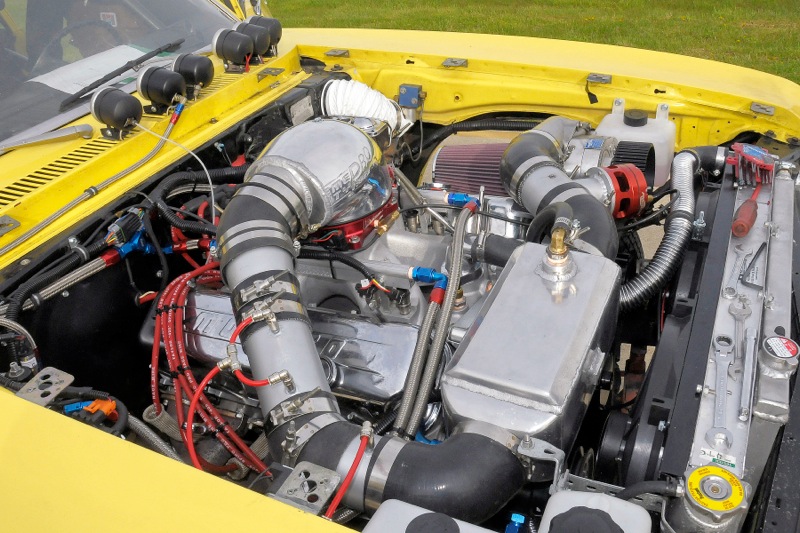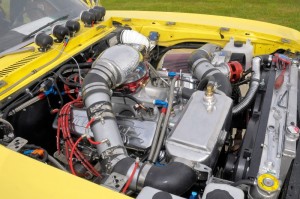
The East Coast Timing Association (ECTA) might be a mystery to some motorsports fans. For nearly 20 years, its vehicle and motorcycle racing venues have been held at two defunct airports east of the Mississippi.
But those in the know will tell you that the Speed Trials group is one of a number of automotive land racing venues in the country that is really “taking off.” The organization was formed in 1995 by two ex-Bonneville racers who started racing on a deserted WWII Army base near Maxton, NC.
However, in 2011, the promoters were notified they could no longer hold racing events at the site. So, after 16 years of using the North Carolina air base for grassroots speed trials, the association took flight to hold venues at another airpark.
Enter the town of Wilmington, OH, which had been financially devastated by the departure of freight hauler DHL U.S. Express. The shipping company’s departure left behind not only a gap in the city’s budget, but a vast aircraft facility with miles of smooth, wide runways.
Deals were made and starting in 2012, ECTA racing was initiated at that location.
ECTA 2014 Schedule
May 3-4
June 7-8
July 12-13
September 27-28
Source: http://ecta-lsr.com
Rules of the Road
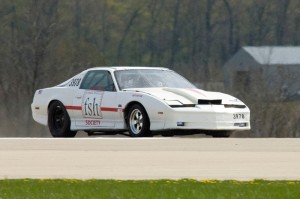
A little explaining is probably required on the “hows and whys” of this growing motorsports activity. The goal is to determine the top speed of a vehicle from a standing start, getting up to speed and passing through a 300-foot speed trap at the end of the first mile and then getting it stopped before running out of concrete.
It could be loosely compared with drag racing, but the difference is that the max speed takes place in the middle of the track instead of at the end. The effects on the engine are harder with land speed racing, since the engine is under load for a much longer period than the several seconds of a drag run.
Speed Run Engines
One might visualize the super-sleek streamliners would be the vehicle of choice, but that’s just not the case here. The sport is designed to be affordable with numerous classes with engines as small as 44 cid engines up to blown big block machines. With that in mind, it’s easy to understand that speeds vary from well less than 100 mph and up to 250 mph.
Land speed powerplants are many times one-of-one, varying greatly with single and multi-carbs, fuel injection, turbo-charging, supercharging, nitrous, and just about anything else.
Some of the engines are professionally built, while others are created in the home garage. Engine brands were also quite varied with both American and foreign brands represented.
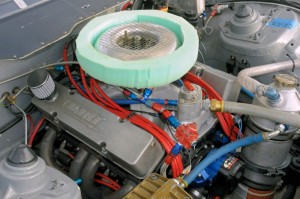
Track Stars
The following are a few of the powerplants that have taken on the Ohio Mile, as well as some details on their build.
1988 Firebird/355ci Carbureted Chevy
This C Production machine uses a 355ci engine with a steel Bowtie Performance Block, Holley 750 cfm double pumper carb, a .660 lift Crane Cam, Dart Steel Heads, and considerable valve and head work.
It makes 560 hp at 8500 rpm burning 110 octane pump gas. This is its fifth year of racing. The $15,000 engine uses a mechanical fuel pump for safety reasons.
Wrench turner/driver Fred Mulliver explained, “If the engine stops, there is no fuel flowing.” Mulliver explained the importance in this engine design. “We have a flat torque curve between 4000-6500 rpm. It’s needed because there is a lot of air to push. We get most of our speed in the first half mile of about 160 mph in a 190 mph run.”
Oil temperature reaches 230 degrees F at the end of the run. Mulliver indicated that the car is owned and co-driven by Jeff Jacobs.
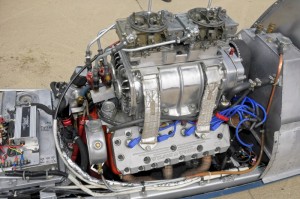
XF Class Drop-Tank Lakester/239ci Blown Flathead Ford
If that looks like a tip tank, that’s exactly what it is. It’s actually off of a WWII Navy Bearcat, said owner Ron Sangiovanni. “It was buried and was part of an old bomb shelter. I considered it as the ‘holy grail.’”
Cradled within is a vintage Ford 239 Flathead V8 (which Sangiovanni builds) with a quite unexpected 6.71 blower on top, this engine makes an amazing 450 horsepower using 117 octane fuel.
Sangiovanni explained that this isn’t an original vintage speed run vehicle, but he built it to resemble the originals as close as possible. “There are just a handful of those late 1940s Lakesters left today, and some of them still run,” the Wallington, CT, native explained.
The engine was built to live with a late 1980s French flathead block. “They were cast with a high nickel content which really made it a rock.”
A drag racer, Sangiovanni echoed the common opinion that speed runs are a different animal. “With the longer runs, the tune-up is very important and I work hard to get the same pressure on each of the eight cylinders. “The goal was to enter the speed trap at about 6400 rpm. I put it into third gear shortly before hitting the trap. My best time is 171.89 mph,” he exclaimed.
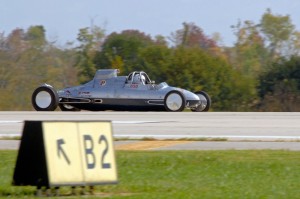
1971 Nova/540ci Blown BB Chevy
Keith Vandenburg admits that he’s an amateur at this speed trial game, but he’s learning fast. His ’71 Nova carries a custom alcohol-injected 540ci big block Chevy hooked to an F2 Pro-Charger Supercharger, which enables in excess of 1300hp. Cooling is accomplished by a homemade intercooler that Vandenburg constructed from spare parts.
“I have used the car for drag racing up until now, but decided to try it in the speed trials for the first time. I really enjoyed it more since there was time to check the gauges and make changes during the run,” the Ontario, Canada resident explained.
His best effort on the drag strip was 145 mph done in 10+ seconds. “In the speed trials, I was able to reach 210 mph,” he said, adding, “With the dragster, the engine is hitting 6000 rpm after the quarter mile.
’94 Nissan/183ci Dual-Carb Half-Ford V8
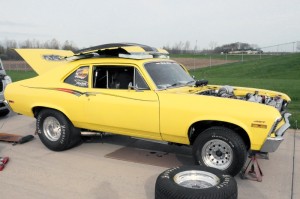
One of the few import-label cars was this unique Nissan 240SX. It was identified as carrying small block Ford power, but that didn’t jive with the Three Liter Class in which it ran.
Owner/driver Don McMeekin of Westerville, OH, who works as an industrial designer, explained his unique powerplant. “I wanted something a little different, so I actually cut the V8 in two and used half of it,” McMeekin said. “Then, I added a pair of Holley 350 cfm two-barrel carbs. I spaced them so that they would line up with the ports and provide better flow. I initially tried a single four-barrel, but this set-up worked best.
“Next I added some good parts with a flat 180-degree Moldex Crank and a Racer Brown Roller Cam. It’s got a dry sump oiling system, and finally, there is an FMS aluminum cylinder head. It makes about 300 horsepower at about 8,000 rpm.”
McMeekin indicated that he thinks this is a pretty optimum set-up for this type of racing. “I ran 173 mph at Bonneville where the record is 174. At Wilmington, I ran 151. It’s a ball of fun for me and I hope to keep getting those trap speeds higher and higher.”
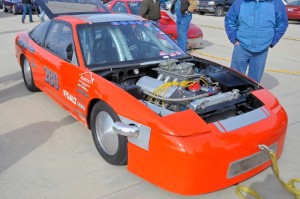
2010 Dodge/358ci Dual-Carb NASCAR V8
One of the most familiar vehicles at the event was a NASCAR-appearing Dodge Charger with the even-more-familiar ‘Keselowski’ name down its side. Cousins Brad and Brian are now driving in NASCAR.
As many know, that family and that engine brand have been uttered as one for many years. Ron (Brad’s dad) and Bob (Brian’s dad) were on hand with the car and made an awesome 250 mph run through the traps. Both had racing careers using Mopar power.
For this application, a modified nose was installed which provided better aerodynamics. Also, the off-set of the body was eliminated by removing the right rear quarter. There is also a larger spoiler in the rear.
Engine modifications saw the addition of a twin four-barrel carb set-up which provided about 845 horsepower from the 5.7L NASCAR Mopar engine. The car first ran in 2012, but many more runs are planned with further refinements.
1955 Crosley/44 ci Carbureted Crosley
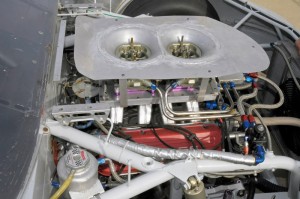
Granted, there are a number of classes in ECTA, but when you hear that the Class XX allows engines of less than a 100 ci, you have to be surprised. Would you believe that a ’55 Crosley Super Sport carrying a 44 ci engine capable of putting out 60 hp at the wheels could top 100 mph? It’s true.
Using a tiny Weber 2-barrel carb, it was clocked at 108+miles per hour through the traps.
*Photos by Phil Kunz

